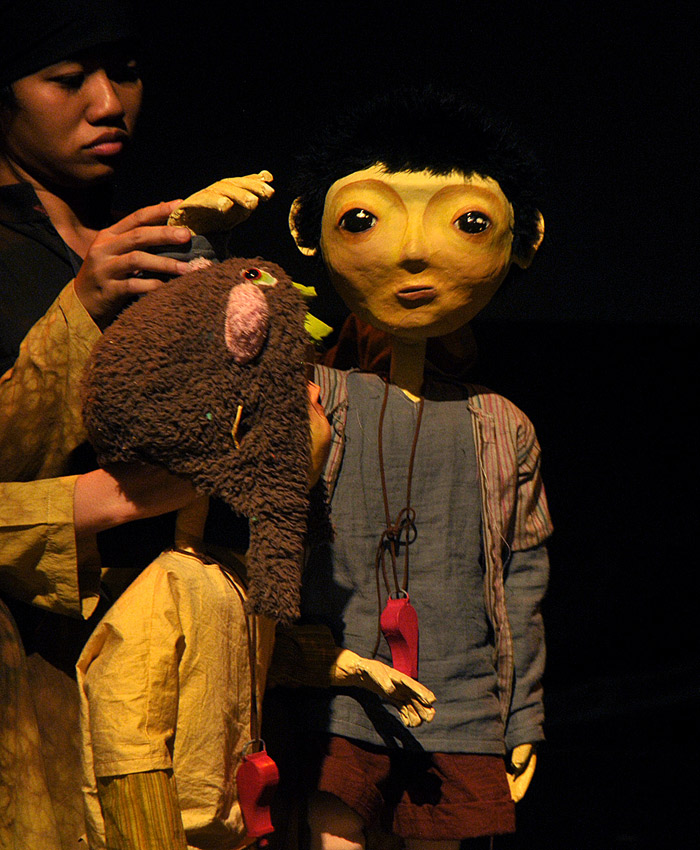The massacre of hundreds of thousands of Indonesians in an anti-communist purge 50 years ago is the backdrop for a haunting puppetry show being presented at this year’s OzAsia Festival.
Papermoon Puppet Theatre co-founder and director Maria Tri Sulistyani says Mwathirika is a traditional Indonesian teater boneka performance, combining theatre, visual art, video, masks, music and light, but using no verbal dialogue.
It sheds light on the 1965-66 tragedy with a story told through the eyes of a family and their neighbours in a small rural village.
Here, Tri Sulistyani explains the history at the heart of the production, and how Mwathirika has brought tears to the eyes of audience members all over the world.
Mwathirika is inspired by a dark period in Indonesia’s history. Tell us about that time …
As an effect of the Cold War, in 1965 there was a coup d’etat in Indonesia to remove Soekarno (the first president of Indonesia) from his throne.
The tragedy started with the killing of seven generals on September 30, 1965, and [in reprisal] members of the Communist Party and any socialist organisation in Indonesia were subjected to persecution. Following that, the random, big genocide occurred to get rid of communists in Indonesia.
There were millions of victims and most of them were innocent. The worst part was that people were taken randomly and millions were killed and jailed for almost 20 years, without any court hearings. And for those who are still alive, they were stigmatised and rejected from society.
These events stretched over many years and many names disappeared from families – it’s an event most Indonesian people don’t want to talk about.
 Why did you decide to make a work about this period?
Why did you decide to make a work about this period?
Mwathirika was produced in 2010, 11 years after the reformation era started in Indonesia. But it’s still a topic that lots of people don’t want to talk about. The young generation don’t know about this time in Indonesia’s history. Lots of people don’t care.
For us, the biggest victims are those who don’t know, so we decided to make Mwathirika as reminder, so that this kind of tragedy will never happen again.
To what extent does the show draw on real personal stories?
While creating Mwathirika, we conducted extensive interviews with elderly people who lived during the period depicted. We also interviewed families of victims of the genocide. From these interviews, we made a collage of stories to form Mwathirika.
How were the puppets created?
The process of making them took one year from research to the first performance. The puppets were made from paper, rattan, wood and foam, using a papier mache technique.
Although the performance focuses on Indonesian political issues, it has been performed all over the globe. How has the audience response differed in various parts of the world?
Mwathirika is based on Indonesian history, but it also mirrors other political turmoil that happens around the world.
We used lots of metaphors on stage and create an anonymous world with no verbal dialogue, through use of gestures, music and lights. In this way, Mwathirika speaks a universal language.
When we’ve performed in other countries around the world, many audience members come to us and relate the story to their own history. In the US, we had two older ladies from Germany and the Philippines who said that a similar tragedy had happened in each of their families. We’ve had similar feedback from audiences in China, Vietnam and Thailand.
Because Mwathirika examines the loss experienced by an individual family, audiences can reflect on loss they have experienced in their own family.
Every show ends with the audience having tears in their eyes and for us, that’s a reminder that if you really connect emotionally to a show, you will remember it for a long time to come.
Papermoon Puppet Theatre will present Mwathirika in the Rehearsal Room, Adelaide Festival Centre, on September 25 and 26 during the OzAsia Festival.
More OzAsia Festival stories:
OzAsia goes to the cutting edge (full program preview)
A slice of modern Indonesian street life





